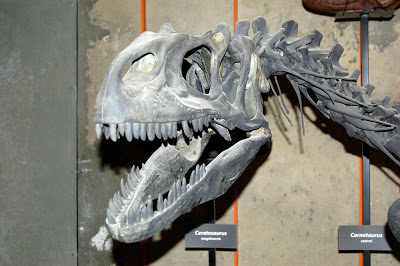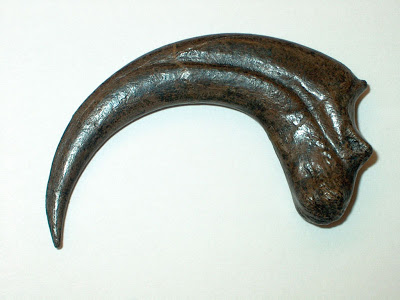

| Visitors Now: | |
| Total Visits: | |
| Total Stories: |

| Story Views | |
| Now: | |
| Last Hour: | |
| Last 24 Hours: | |
| Total: | |
SVP 2012 – Theropods Part 2
Sunday, December 2, 2012 15:10
% of readers think this story is Fact. Add your two cents.
The teeth of dinosaurs continue to fascinate. They are often well preserved, vary in shape and can be extremely large and impressive. They have also been intensely studied for function and morphology – I am fully aware of this fascination since I myself have been researching tyrannosaur teeth for a few years now.
But claws are another matter and, in particular, the manual unguals. But now Christopher Noto, of the University of Wisconsin-Parkside, has started to address this issue. Claws, like teeth, also show a huge variance in morphology but despite this it would appear that they were all universally utilised for predation. But is this actually the case?
The author analysed a total of 200 claws representing 80 taxa and a combination of methodologies including principal component analysis, reveal that nail curvature and nail size (relative to the ungual body) display the most morphological change and variance. This analysis also reveals that digit 1 is nearly always the most morphologically different when compared with the other digits.
Highlights include the fact that there is a significant difference in claw shape between coelurosaurs and non-coelurosaurs and the author suggests this demonstrates that coelurosaurs were ecologically more diverse. Non-coelurosaur claws are nearly always evolved with predation in mind. The diversification in coelurosaurian claws can be seen to evolve in stages as each clade moves to more derived forms. Examples include tyrannosaurid claws which are wickedly hooked and ornithomimids claws which became longer and straighter. Aviale and Deinonychosauria demonstrate a further extreme morphology which is likely to be indicative of a specialist climbing and/or grasping adaption.
This research into claw morphology and function further highlights the amazing variety within Theropoda and is a useful tool for determining their ecological differences and as an aide in establishing the mechanics of the theropod manus and, ultimately, will be useful for cladistics.
Oliver Rauhut, of the Bayerische Staatssammlung für Paläontologie und Geologie in Munich and Pol Diego, of the Museo Paleontológico Egidio Feruglio in Argentina, presented at SVP a quite bizarre looking new basal tetanuran. The specimen was found in the Middle Jurassic Cañadón Asfalto Formation in Chubut Province, Argentina. This formation has already revealed two other similar forms in the shape of Piatnitzkysaurusand Condorraptor.
The images presented revealed an unusual suite of characters that were readily apparent even though we were looking at the screen from distance. The specimen is fairly complete with elements of both the axial and appendicular skeleton present and, most importantly, a virtually complete skull. Any tetanuran from the Middle Jurassic is rare and to have one preserved this way is quite spectacular.
Firstly, it is a large animal with the skull around 0.8 metres in length. Secondly, it is clearly different from the aforementioned Piatnitzkysaurus and Condorraptor and was designated as a new taxon almost immediately. It does, however, demonstrate a suite of characters that are almost mongrel-like in their affinities. There are the expected multiple tetanuran synapomorphies but there are also unexpected plesiomorphic characters, such as the short and distally expansive scapula, that are not usually seen in tetanurans.
To confuse matters more, the animal also shares derived characters that are found in both megalosauroids and allosauroids. For example, the maxillary fenestra is closed medially (a character found in megalosauroids) but the well developed lacrimal horn is clearly an allosauroid trait. This specimen is SO weird but, since it is a basal tetanuran, incredibly important and the bizarre combination of characters lead the authors to believe that a monophyletic Carnosauria is a very real possibility or, on the other hand, may be evidence of homoplasy in early tetanuran evolution. My feel from the authors on this is that they favour the first option.
 |
| Allosaurus |
The Witmer Lab of Ohio University was well represented at this year’s SVP and one study, led by Eric Snively, looked at feeding motions in that well known Late Jurassic theropod Allosaurus. Despite numerous studies that have analysed the biomechanics of the skull, very little research has looked at the overall motion of the head and neck. In this case, the authors used one well preserved specimen to use for their template.
Typically, the authors utilised the very latest in digital technology to bring these motions to life in Allosaurus. A combination of CT scanning of the skull and soft tissue reconstruction enabled three dimensional modelling that was highly detailed and included reconstructing sinuses, airways and bone density. Multi-body dynamics allowed that their attention to detail and allowance for every single known permutation and/or variation enabled them to come up with the most vigorous reconstruction yet of Allosaurus.
This specimen of Allosaurus has demonstrated that lateral angular acceleration was rapid – twice as fast as those calculated for Tyrannosaurusalthough dorsiflexive acceleration was comparable. Powerful coordination of lateroflexive muscles enabled rapid flexion of the cervical spine allowing the head to move down fast. However, due to the narrow build of the skull and a low ability in being able to power the head in a side to side motion suggests that Allosaurus pulled its head right back when feeding – a motion reinforced by the high sagittal mobility of the neck.
This combination of evidence suggests that Allosaurus dismembered and fed on their carcasses very much like raptors of today and are therefore very different from tyrannosaurids and crocodiles.
The Lower Cretaceous Cedar Mountain Formation of Central Utah is clearly an important formation and no doubt harbours many interesting fossils from this crucial period in dinosaurian evolution. There are many clues and I (amongst many) have been waiting for more remains of the elusive Cedar Mountain tyrannosauroid to come to life – so far only represented by teeth. But whilst waiting for that, another large theropod has appeared and Lindsay Zanno, of the North Carolina Museum of Natural Sciences, and colleagues have brought this important new animal to light.
Firstly, not only does this animal represent another new taxon, but, more importantly, represents the latest surviving allosauroid yet known from North America. Although there is no skull material available, there is enough of the skeleton to be able to refer the specimen to Carcharodontosauria and particularly displays high axial pneumaticity. This animal shares morphologies with the Neovenatoridae but the most anteriorly positioned centra of the dorsal vertebrae are relatively elongate which neovenatorids do not have. The posterior placed dorsals are similar to those of Neovenator and Aerosteon whilst other details share characteristics with neither carcharodontosaurids nor, indeed, Acrocanthosaurus.
This specimen extends the temporal overlap between carcharodontosaurians and advanced tyrannosauroids in the Early Cretaceous of Western North America although we must accept that there is still so much we do not know about this time period and that sampling remains an issue and, by implication, there remains a huge disparity in the phylogenetic make up of these groups that were coeval at the time.
Next up and worth the wait – tyrannosaurs.
References
Noto, C.R. 2012. What big claws you have: implications of morphological variation in theropod manual unguals. Journal of Vertebrate Paleontology, SVP Program and Abstracts Book, 2012, pp 150.
Rauhut, O.W. and Diego, P. 2012. A new basal tetanuran theropod from the Early Middle Jurassic of Patagonia, Argentina. Journal of Vertebrate Paleontology, SVP Program and Abstracts Book, 2012, pp 160.
Snively, E., Cotton, J.T., Ridgeley, R.C. & Witmer, L.M. 2012. Feeding motions in Allosaurus (Dinosauria: Theropoda): multibody dynamics of the cervicocephalic apparatus suggest rapid lateral strikes but sagittal prey dismemberment. Journal of Vertebrate Paleontology, SVP Program and Abstracts Book, 2012, pp 175.
Zanno, L.E., Makovicky, P.J. & Gates T.A. 2012. A new giant carcharodontosaurian allosauroid form the Lower Cretaceous Cedar mountain formation of Central Utah. Journal of Vertebrate Paleontology, SVP Program and Abstracts Book, 2012, pp 199.
2012-12-02 15:01:52
Source: http://saurian.blogspot.com/2012/12/svp-2012-theropods-part-2.html
Source:



